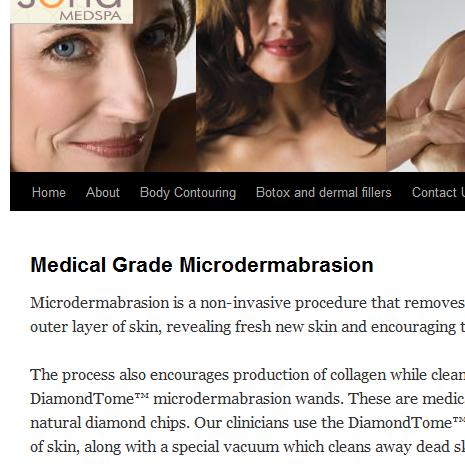Your cart is currently empty!

Making Technical Content Readable
Sometimes you have to share technical information at your website. Making that content readable is very important. If it’s not accessible, research tells us, visitors will leave and go look for something they can understand better.
The example in the image is from a medical spa website. This company injects toxins into people’s skin and scrapes their faces with diamond chips and uses lasers to remove hair. The explanations of these procedures must be clear and accurate, but without being alarming. Your website might also need a readable presentation of technical data.
Here are some questions to ask yourself.
Know your audience
Who’s reading the site — really?
The average person considering skin treatments might not know the difference between a chemical peel and dermabrasion, and will feel much better if it’s clearly explained.
Usually the terminology that comes naturally to you as a professional may not work well with people in other fields. If you have a medical service that is paid for by laypeople, breaking down what you do is key.
What terminology do they use?
Identifying the terms that your audience uses can help with making content more readable. People in different fields describe the same concept in different ways.
For example, people in my field say “image” for “picture.” People who say “picture” really don’t have any difficulty understanding the concept of a picture, but I have seen them look very confused when we were talking about “images.”
Sometimes we imagine that our own jargon is a more precise way to communicate. In fact, using our readers’ jargon, or ordinary shared English, is the best way to communicate clearly.
What are the hard parts?
Some concepts are difficult to grasp. Sometimes new information is difficult simply because it’s new. However, accessing some information is challenging simply because of the form it’s in.
Many people have trouble understanding lots of numbers. Others have a hard time visualizing three dimensional things. Specialists often struggle to imagine the trouble other people have with their specialty.
You can test to see if you need to make your content more readable.
Present your content to people in your target demographic, and ask them to tell you what it said. You might also test it with the secretaries or assistants of people in your demographic, since often the initial looking around may be delegated.
Find the gaps in information, miscommunication, or areas that need further explanation. Then go back and replace some of those numbers and specs with graphs and illustrations. Once you’ve identified the parts of your message that might be challenging to your readers, choose the right techniques to clarify them.
Make your content readable
Simplify the language.
You don’t have to say “abrade” when you could say, “gently removes the outer layer of skin.”
All the words in the second version are common words. It might be that you’ll need more words if you have to use common ones instead of specialized ones, but whatever you have to say can undoubtedly be said in ordinary terms.
Use metaphors.
Sometimes things are hard to grasp, but can be clarified by comparing them to something the readers already understand.
For the medical spa, we’re calling the tool the company uses a “wand.” This will bring to mind a long skinny object that might do magical things. That’s better than calling it “aggressive skin resurfacing tool,” which is completely accurate but unsettling to patients.
Note that we could also have called this thing a “sander,” an equally good metaphor from the point of view of comprehension, but not so good where the connotations are concerned.
Choose something with the right associated feeling.
Focus on the benefits.
It’s difficult for people to understand the specific details of how lasers might safely do things to their skin, but they can understand that they’ll have more even skin tone.
Explain in more than one way.
If something is difficult to understand, use simple language, a metaphor, and focus on the benefits. Keep going, though. Use a good infographic. Write several blog posts or articles that explain the concept or procedure in different ways.
On a website, it makes sense to offer something simple on the homepage and link to more technical information for those who want to understand more fully.
Making technical content more readable is an art
Whatever you do to simplify and clarify, don’t talk down to your readers. People aren’t stupid or ignorant if they don’t happen to know something you happen to know.
Chances are, they know something that you don’t. Keep this clearly in mind as you plan your website in order to avoid sounding condescending or disrespectful.
Does this sound difficult? It’s not hard for us, but it is a specialized skill. We are an independent content marketing firm specializing in medical, health, and wellness websites. If you need to make a compelling story from something complex, contact us. The investment will be worth the results.
by
Tags:

Leave a Reply